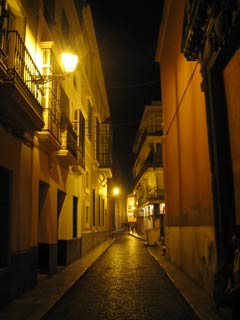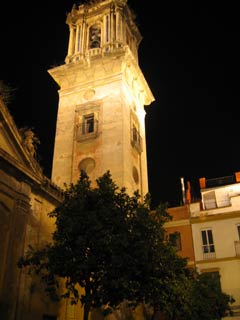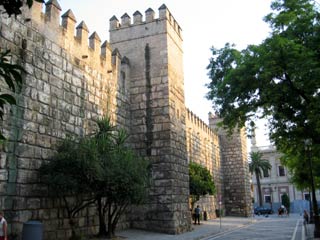
Click above image for more images on Alcazar
Seville was the largest city we visited on this vacation, with a population of 700,000 people. We arrived here at around 2:00pm in the afternoon, and wasted over a couple of hours, driving around lost, until we finally found our hotel. (As a result of that experience, I purchased detailed city maps for Cordoba and for Granada, such that I would not waste so much time lost, when visiting subsequent cities).
Seville has a mix of wide and narrow streets, large green parks, quaint fountains, and a vibrant night life. I read it is also one of the "homes" of bullfighting and flamenco. The places I wanted to visit were the old Cathederal and the Alcazar.
History is one of my fascinations in life, so naturally I had to examine a small part of Seville's history. Like many Spanish cities, there is a lot of history to Seville. It was a great city in Spanish Muslim times, and was great again in the 16th and 17th centuries.
Purportedly the Phoenician influence helped initially mold Seville, and Hercules himself, is purported to have played a key role in the founding of the first settlement where Seville lays, and some of the myth and fact behind the legend of Hercules is purportedly explained here. Later the Romans founded the the Roman town of Hispalis as a river port town, where Seville now lies. Hispalis was also a major town under the Visigoths, and then later a major city under the Muslim Taifa kings when Cordoba "collapsed" as the major Mulsim city. Seville's fortunes varied as various Muslim alliances (against the Christians) resulted in different Muslim rulers. Finally the Castilian (Christian) King Fernando III conquerored Seville in 1248, bring 24,000 Christian Castialian settlers, possibly part of the typical ethnic cleansing that was conducted by all sides in those days.
But it was Christopher Columbus' government sanctioned discovery of the Americas in 1492, that resulted in Seville's golden age, as in 1503 the city was granted an official monopoly on Spanish trade in the newly founded continent.
Since then the city has flourished, and wanned, with the population jumping from 40,000 (in 1500) to 150,000 (in 1600). Half the city was killed in 1649 by a plague. Sandbars and silt clogged the river, and with decreased trade, the population dwindled to 60,000. Another plague in 1800 killed 13,000 and purported Napoleonic troops (who occupied the city from 1810 to 1812) stole much of the city's artistic heritage.
The Alcazar was founded as a fort for the Cordoban governors of Seville in 913. It was expanded and reconstructed many times since then. Click the image for some of the pictures I took while touring this old building complex.
No visit to Seville is complete without visiting the Cathedral. Purportedly, Seville's large Cathedral is the 3rd largest in Christiandom, being 3rd only to the largest Cathedral (St.Peter's Bascilica in Vatican City), and to Saint Paul's in London.
The Cathedral was built on the site of a Muslim mosque. In fact this appeared to be typical for those times, where after a conquest, the Christians (or Muslim's, as the case may be), would build a place of worship on top of the vanquished peoples place of worship. In fact, in view of the large amount of ethnic cleansing documented in Spanish history, I began to ponder a bit the meanings of the word "vanquished". Perhaps it is only in recent times that ethnic cleansing is less prevalent (albeit still very much in existance). Click the picture for some of the images I took inside and outside this immense cathedral.
We wandered a bit around Plaza de Espana and the associated gardens. Plaza de Espana is a relatively new structure, built for the Ibero-American Expo in 1929. There is an overwhelming use of red brick in its construction. While a canal runs around the perimeter of the square, it was unfortunately drained of water during our visit, as there was a lot of reconstruction going on. The place appears to house a number of government offices, but despite that (or maybe because of that) we felt it was a little run down.
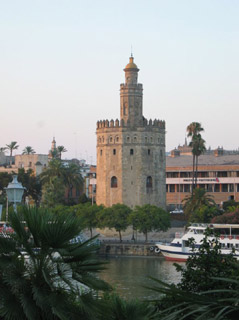
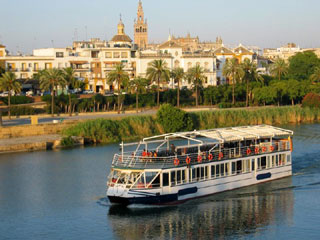

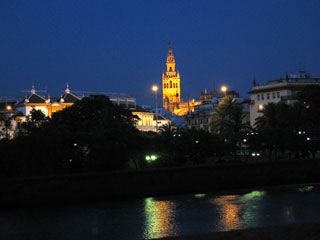
I played around with a small tripod/clamp, and my Canon S400's limited night shot capability. These very feeble early night image attempts started to provide me a hint of something I knew already, BUT that I had to relearn. This tidbit of knowledge was that a good photographer can often pull wonders, even with a limited camera. Eight months earlier, I had watched Croc Dundee take some great night images in Ho Chi Minh City, and I am now thinking it wasn't all his great Olympus camera, but rather he used a lot of skill in producing some good night shots.
In the two images below, I had my camera secured to a sidewalk cafe table, by means of a clamp. The camera is in automatic mode (with the flash supressed). I know, I know, I can hear Spyder and Traveller nodding sagely and helpfully in the background, quietly reminding me that I should take the time to learn how to use the exposure time, ISO and other manual settings on my camera. Still, I have been spoiled by the automatic mode, but who knows what fabulous memories I have failed to capture due to my laziness?
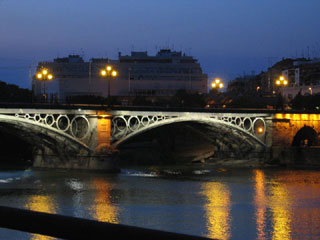
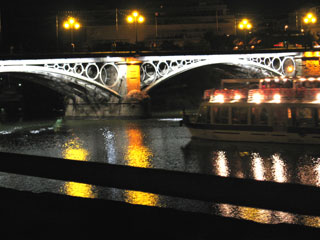
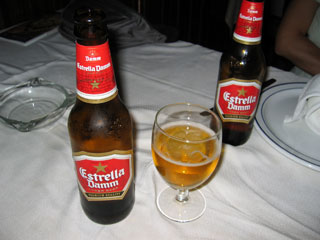
No visit to Andalucia Spain is complete, without watching at least one Flamenco session. Whether this be a spur of the moment spontaneous session in some night club, or an organized tourist function, it is still a necessary cultural event to add to one's list of "must do" events in southern Spain.
I read that Flamenco emerged in the late 18th and early 19th century, although its origins may have included music and verses of the medieval Muslim Andalucia, including possible influences from the Byzantine chants used in Visigothic churches. There is definitely a heavy gypsy influence in how Flamenco has evolved today. Regardless, as to its history, it has an emotional flavour to it, with the right singer and right mood, it can be very abosrbing to experience as on onlooker.
Purportedly the Flamenco exists in three forms: Cante (the song), Baile (the dance), and Guitarra (guitar playing). The image below illustrated that many tourist sessions (such as the one we attended) have all three together.
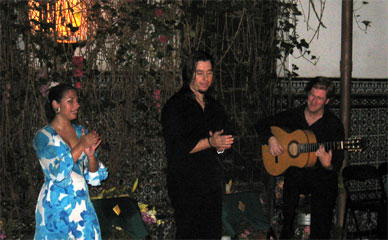
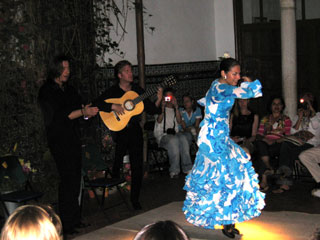
Speaking of the guitar, purportedly today's guitar originated in Andalucia Spain. It was the Arabs who developed an acient Middle Eastern stringed instrument, the "cithara", into a four-stringed lute. In 9th-century Cordoba a fifth string was added, and this instrument was widespread in Spain for centuries. A 6th string was added in the 1790's, and in the 1870's the guitar was brought to its modern shape by enlargening the two bulges and placing a bridge centrally over the lower one, to give the instrument its "carrying power".
We never visited a "real" Bodega (wine cellar) where wines and sherry were made, but we did visit a number of wine bars that called themselves Bodega's. The Bodega's we visited appeared to have an excellent selection of wines. Having noted the great selection, I usually "wimped out" and instead enjoyed sampling the "house wine" (as it was easy to order with my limited two-dozen word Spanish vocabulary). My wife usually tried out various Sherries offered by the many Bodegas.
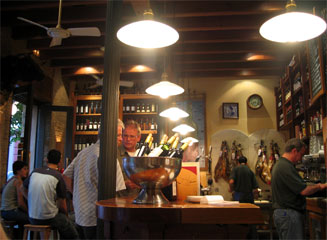
The nightlife appeared to often be congrugated around a series of popular streets and plazas. The maze of streets and plazas around Santa Cruz Plaza was our favourite "stomping" ground.
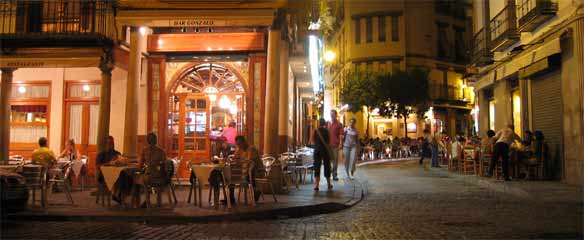
I read somewhere that the area along the Rio Guadalquivir on "Calle de Betis" was where the liveliest part of Sevilla's night life flourished. We visited there early one evening, departing (after supper) at 11:00pm, when the place was just starting to wake up, in preparation for the evenings joy of life. There were a number of discos, wine bars, sidewalk "cafes", and various places for one to meet a new companion, and chat about inconsequential things, while getting a feel for the possibilities for one or more night's daliance.
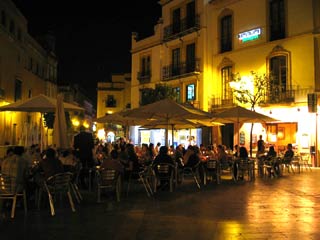
We also visited Plaza del Salvador and Plaza de la Alfalfa at around midnight. Plaza del Salvador was very subdued, with only one bar and a few dozen people enjoying the warm night air. I suspect we were too early for Plaza del Salvador. On the other hand Plaza de la Alfalfa was more lively, with a dozen different bars opened, with many different people gearing up for an evening of fun. We never made it to Almadeda de Hercules at night. Purportedly it also comes alive, with a mix of different types of bars and live music venues.
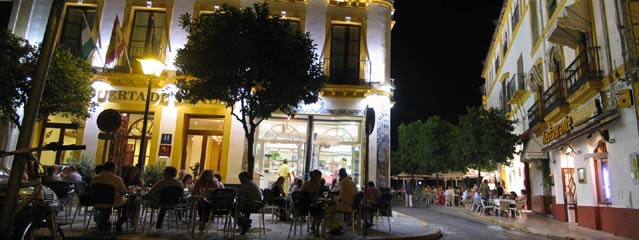
But for us, all roads lead to the Santa Cruza area, close to the Cathedral, and we never grew tired of wandering around the old streets (in this old jewish quarter) at all hours of the night
